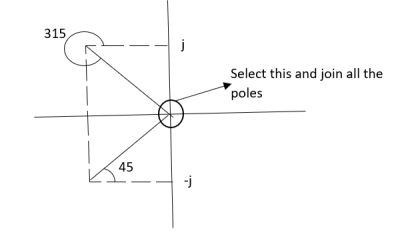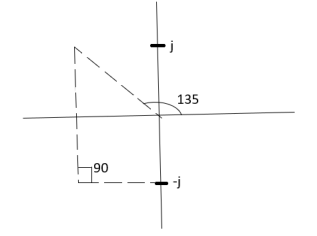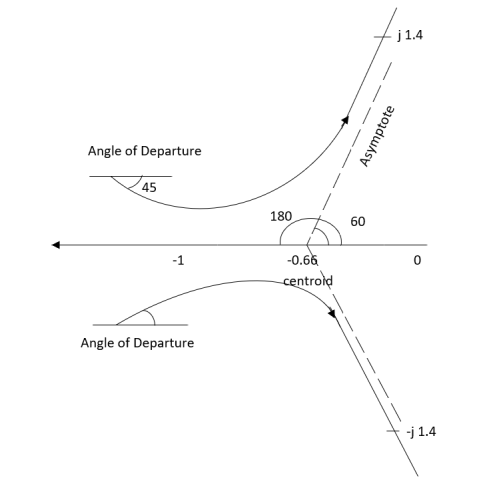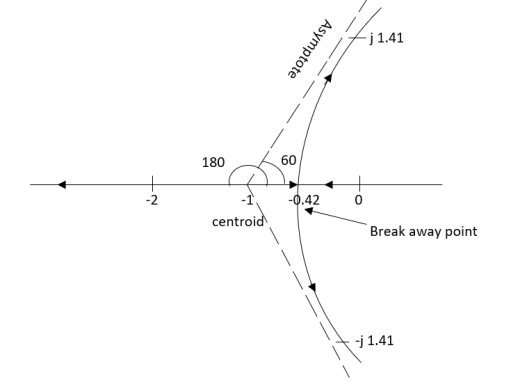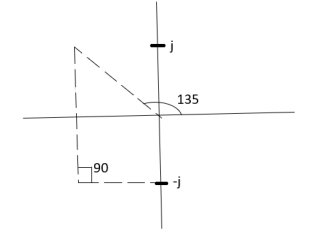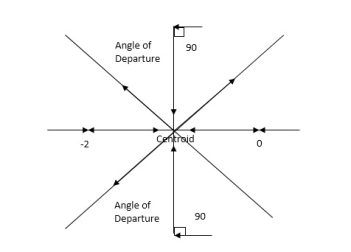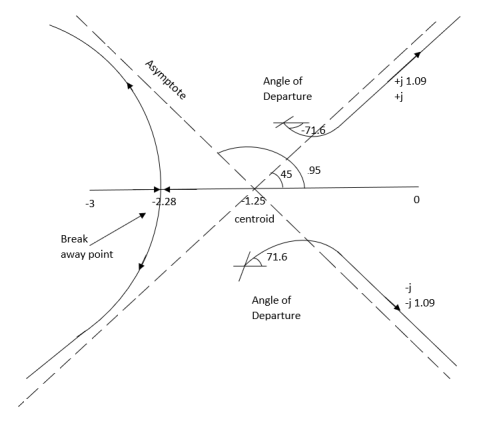 .A1) G(s) =
.A1) G(s) =  Number of Zeros = 0Number of polls S = (0, -1+j, -1-j) = (3).1) Number of Branches = max (P, Z) = max (3, 0) = 3.2) As there are no zeros in the system so, all branches terminate at infinity.3) As P>Z, branches terminate at infinity through the path shown by asymptotes
Number of Zeros = 0Number of polls S = (0, -1+j, -1-j) = (3).1) Number of Branches = max (P, Z) = max (3, 0) = 3.2) As there are no zeros in the system so, all branches terminate at infinity.3) As P>Z, branches terminate at infinity through the path shown by asymptotes Asymptote = P=3, Z=0. q= 0, 1, 2. For q=0 Asymptote = 1/3 × 180° = 60° For q=1 Asymptote = = 180° For q=2 Asymptote = Asymptotes = 60°,180°,300°. 4) |
Centroid =
= Centroid = -0.66
|
øD = (2q+1)×180°+ø ø = ∠Z –∠P. Calculating ø for S=0 |
|
ø = ∠Z –∠P. = 0-(315°+45°) = -360° ØD = (2q + 1)180 + ø. = 180° - 360° ØD = -180° (for q=0) = 180° (for q=1) =540° (for q=2) |
|
ø = ∠Z –∠P. = 0 –(135°+90°) = -225° ØD = (2q+1) 180°+ø. = 180-225° = -45°
ØD = -45° (for q = 0) = 315° (for q = 1) = 675° (for q =2) |
1+G(s) H (s) = 0 1+
S (S2+2s+2)+k = 0 S3+2s2+2s+K = 0
For stability 0<K<2. So, when K=2 root locus crosses imaginary axis S3 + 2S2 + 2S + 2 =0 For k Sn-1 = 0 n : no. of intersection S2-1 = 0 at imaginary axis S1 = 0
K<4 For Sn = 0 for valve of S at that K S2 = 0 2S2 + K = 0 2S2 + 2 = 0 2(S2 +1) = 0 32 = -2 S = ± j |
|
 Q2)Sketch the root locus plot for the following open loop transfer function G(s) =
Q2)Sketch the root locus plot for the following open loop transfer function G(s) =  A2)
A2)
Asymptote = P=3, Z=0 q= 0,1,2.
For q = 0 Asymptote = For q=1 Asymptote = For q=2 Asymptote =
Centroid =
=
So, calculating breakaway point.
The characteristic equation is 1+ G(s) H (s) = 0. 1+
K = -(S3+3S2+2s)
3s2+6s+2 = 0
S = -0.423, -1.577.
So, breakaway point is at S=-0.423 because root locus is between S= 0 and S= -1
Characteristics equation is
S3+3S3+2s+K = 0
For k Sn-1= 0 n: no. of intersection with imaginary axis n=2 S1 = 0 K < 6 Valve of S at the above valve of K Sn = 0 S2 = 0 3S2 + K =0 3S2 +6 = 0 S2 + 2 = 0 S = ± | ||||||||||||
|
 The root locus plot is shown in fig. 2.Q3) Plot the root locus for the given open loop transfer function G(s) =
The root locus plot is shown in fig. 2.Q3) Plot the root locus for the given open loop transfer function G(s) =  A3)
A3)Asymptote =
q=0,1,2,3. (P-Z = 4-0)
for q=0 Asymptote = For q=1 Asymptote = For q=2 Asymptote = For q=3 Asymptote =
Centroid = Centroid = 6) As poles are complex so angle of departure is ØD = (2q+1) ×180 + ø ø = ∠Z –∠P. A) Calculating Ø for S=0
ø = ∠Z –∠P. = 0 –[315° + 45°] Ø = -360°
For q = 0 ØD = (2q+1) 180° + Ø = 180 - 360° ØD = -180° b) Calculating Ø for S=-1+j ø = ∠Z –∠P. = 0-[135° + 90° + 90°] Ø = -315° For q=0 ØD= (2q+1) 180° +Ø = 180° -315° ØD = -135° ØD for S=1+j will be ØD = 45° 7) As the root locus lie between S=0 and S=-1 So, the breakaway point is calculated
1+ G(s)H(s) = 0 1+ (S2+S)(S2 +2S+2) + K =0 K = -[S4+S3+2s3+2s2+2s2+2s]
S = -0.39, -0.93, -0.93. The breakaway point is at S = -0.39 as root locus exists between S= 0 and S=-1 8) Intersection of root locus with imaginary axis is given by Routh Hurwitz I + G(s) H(s) = 0
For system to be stable
6.66>3K 0<K<2.22. For K = 2.22 3.3352+K =0 3.3352 + 2.22 = 0 S2 = -0.66 S = ± j 0.816. The root locus plot is shown in figure 3. | ||||||||||||||||||||
|
 Q4) Plot the root locus for open loop system G(s) =
Q4) Plot the root locus for open loop system G(s) =  A4)
A4)Asymptote = q = 0,1,2……p-z-1 For q = 0 Asymptote = 45° q=1 Asymptote = 135° q=2 Asymptote = 225° q=3 Asymptote = 315°
Centroid = = Centroid = -1.
ØD=(2q+1)180° + Ø ø = ∠Z –∠P = 0-[135°+45°+90°] = 180°- 270° ØD = -90°
1+ G(s)H(s) = 0
1+
K = -[S4+2S3+2S2+2S3+4S2+4S] K = -[S4+4S3+6S2+4S]
S = -1 So, breakaway point is at S = -1
S4+4S3+6S2+4s+K = 0
K≤5. For K=5 valve of S will be. 5S2+K = 0 5S2+5 = 0 S2 +1 = 0 S2 = -1 S = ±j. The root locus is shown in figure 4. | ||||||||||||||||||||
|
 Q5) Plot the root locus for open loop transfer function G(s) =
Q5) Plot the root locus for open loop transfer function G(s) =  A5)
A5)Asymptote = For q = 0 Asymptote = 45 For q = 1 Asymptote = 135 For q = 2 Asymptote = 225 For q = 3 Asymptote = 315 (4). The asymptote intersects real axis at centroid. Centroid = ∑Real part of poles - ∑Real part of zero / P – Z = [-3-1-1] – 0 / 4 – 0 Centroid = -1.25 (5). As poles are complex so angle of departure φD = (29 + 1)180 + φ
ø = ∠Z –∠P. = 0 – [ 135 + 26.5 + 90 ] = -251.56 For q = 0 φD = (29 + 1)180 + φ = 180 – 215.5 φD = - 71.56 (6). Break away point dk / ds = 0 is at S = -2.28.
(7). The intersection of root locus on imaginary axis is given by Routh Hurwitz. 1 + G(S)H(S) = 0 K + S4 + 3S3 + 2S3 + 6S2 + 2S2 + 6S = 0 S4 1 8 K S3 5 6 S2 34/5 K S1 40.8 – 5K/6.8 K ≤ 8.16 For K = 8.16 value of S will be 6.8 S2 + K = 0 6.8 S2 + 8.16 = 0 S2 = - 1.2 S = ± j1.09 The plot is shown in figure 20.
|
|
 Q6) Sketch the root locus for open loop transfer function. G(S) = K(S + 6)/S(S + 4)A6)
Q6) Sketch the root locus for open loop transfer function. G(S) = K(S + 6)/S(S + 4)A6)1 + G(S)H(S) = 0 1 + K(S + 6)/S(S + 4) = 0 dk/ds = 0 S2 + 12S + 24 = 0 S = -9.5, -2.5 Breakaway point is at -2.5 and Break in point is at -9.5.
G( + jw) = K( + jw + 6)/( + jw)( + jw + 4 ) = +- π tan-1 w/ + 6 - tan-1 w/ – tan-1 w / + 4 = - π taking tan of both sides. w/ + w/ + 4 / 1 – w/ w/ + 4 = tan π + w / + 6 / 1 - tan π w/ + 6 w/ + w/ + 4 = w/ + 6[ 1 – w2 / ( + 4) ] (2 + 4)( + 6) = (2 + 4 – w2) 2 2 + 12 + 4 + 24 = 2 + 4 – w2 22 + 12 + 24 = 2 – w2 2 + 12 – w2 + 24 = 0 Adding 36 on both sides ( + 6)2 + (w + 0)2 = 12 The above equation shows circle with radius 3.46 and centre (-6, 0) the plot is shown in figure 6
Fig 6 Root locus for G(S) = K (S + 6)/S (S + 4)
|





